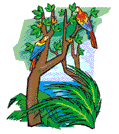Classifying Animals
A lesson and worksheet on classifying animals.
Objectives:
• Students will be able to describe how animals are classified.
• Students will understand that animals are classified as vertebrates or invertebrates and that there are subgroups of each of these classes of animals.
• Students will be able to describe the unique characteristics of specific groups of animals.
Suggested Grades:
3rd Grade - 4th Grade - 5th Grade
Print the reading comprehension worksheet passage and questions (see below).
Students should read the passage silently, then answer the questions. Teachers may also use the text as part of a classroom lesson plan.
Lesson Excerpt:
All animals are classified into groups according to things they have in common with other animals in that group. For example, animals with hair are not in the same groups as animals with feathers. The first major difference that separates groups of animals is whether or not they have backbones. Animals with backbones are called vertebrates. Animals without backbones are called invertebrates. Each of these groups is divided into even smaller groups.
Examples of groups of invertebrates are sponges, flatworms, roundworms, segmented worms, mollusks and arthropods. Sponges have hollow tubes with holes called pores throughout their bodies. Flatworms, as the name suggests are flat worms! They have heads and tails but do not have true organs like stomachs, lungs, etc. Roundworms have round bodies, a digestive system and a nervous system. Segmented worms are more complex than flatworms and roundworms.
Continued...

Lesson Printables:
Print this printable worksheet for this lesson:


